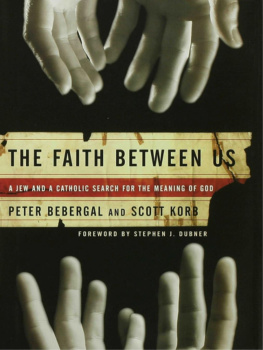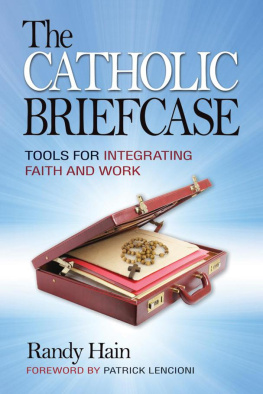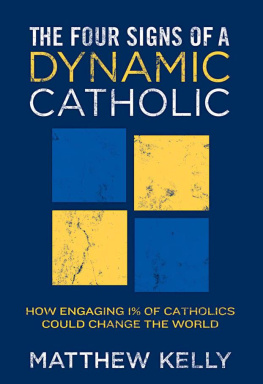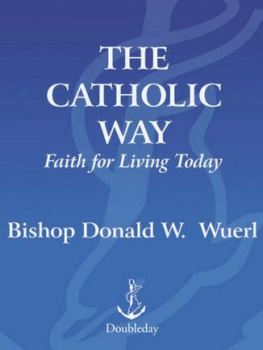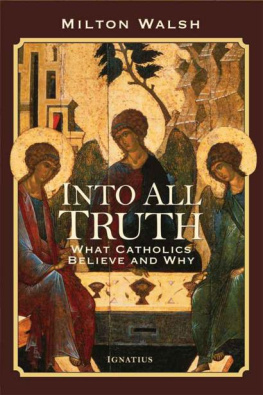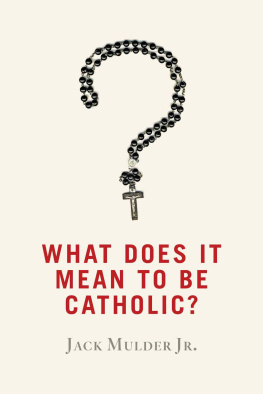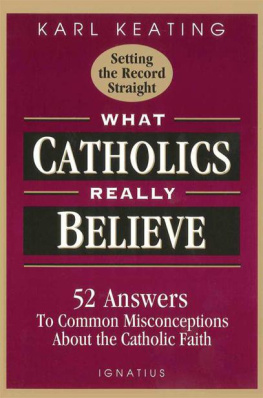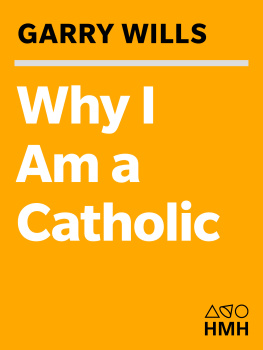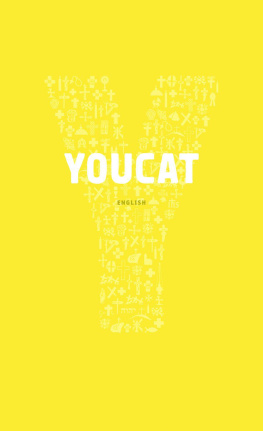
Loyola Press
3441 N. Ashland Ave.
Chicago, IL 60657
(800) 621-1008
www.loyolapress.com
2012 Catherine Wiecher Brunell
All rights reserved.
Scripture quotations are from the New Revised Standard Version Bible: Catholic Edition, copyright 1989, 1993 National Council of the Churches of Christ in the United States of America. Used by permission. All rights reserved.
Art credit: Warling Studios.
Library of Congress Cataloging-in-Publication Data
Brunell, Catherine Wiecher.
Becoming Catholic, again : connecting the faith we were taught with the faith we live / Catherine Wiecher Brunell.
p. cm.
ISBN-13: 978-0-8294-3751-5
ISBN-10: 0-8294-3751-7
1. Brunell, Catherine Wiecher. 2. Catholics--Biography. 3. Catholics--Religious identity. I. Title.
BX4705.B8773A3 2012
282.092dc23
[B]
2012021413
ePub ISBN 978-0-8294-3752-2
12 13 14 15 16 EPUB 5 4 3 2 1
Finding the Path, Living the Story
When we are quiet, and when we take a minute to listen to our lives, something pulls at us. For me, it has always been the quest for meaning; my mind and spirit naturally drift to making sense out of what I encounter. I ask questions such as Is my life on the right track because of this? Whats the lesson this time? and most deeply, What is my purpose, and what do I use to get there? We are naked before the experiences of life, and we drape ourselves in the meaning that explains who we are and how we frame our experiences. From that meaning, we land on an ethic, a way of seeing and being in the world, that makes sense from our vantage point. As we define it, our ethic drives us toward everything that matters.
For my first twenty years, my Catholic faith mattered. It was the source I relied on to make sense of things. I was raised Catholic in a parish that served pancake breakfasts and had a huge carnival each summer. It was the place of my first communion, my wedding, and later, my son Hanks baptism. I also attended school there for thirteen years. I won my first political office in student council, I learned to play soccer, and I met my first love, all within a three-building complex. Then, in what I thought at the time was just a coincidence, I found myself at a Catholic college. What I know now is that Catholicism is my first language in meaning-making. I am drawn to it because its symbols, rituals, and community feel like home.
But, as with the physical home of childhood, we find it difficult to remain there at times. We evolve, but the roles we play and that others play for us in that space called home do not always adapt in tempo. I hit this tension in faith and thus became a reluctant Catholic. I wanted my relationship with God but not the limited experience I saw in the church. I continued to attend Mass and be part of various churches, but I often left the experiences feeling annoyed or offended. I thought of the church as another mans club and vowed to pray only with feminine images. And yet, even though I was so angry, I still could not leave completely. I was a resentful Catholic and felt shut out of the very place that had prompted many of the questions I was asking. This is not unlike being lured into a situation or behavior by an older sibling only to be left alone when something goes wrong.
At that point, I chose distance. To my benefit, the longing to be connected to my faith only intensified. What was essential about a spiritual life began to emerge because of its absence. Having a new definition of what I needed and wanted, I saw that I was actually very Catholic and in a way that was congruent with my experience and the tradition I loved. With a clarified vision of the whys and hows of my spiritual life, I began letting go of the stuff that was preventing me from celebrating it. I saw that being Catholic as I am is the only way I will ever be Catholic, and it is enough.
Theologian Paul Tillich once wrote Faith is the courage to accept our acceptance. This struck me when I was struggling to find a way to be Catholic, because it made the quest internal. God is simply asking us to be who we already are and therefore to be part of the story that is unfolding. Zen Buddhism puts it another way: Do nothing extra. When I can trust that it is that simple, I know that our human vocation is to dig inward and find that divine gift of our fullest selves, a gift that is already there. It has been placed gently within our capacity from our very beginning. The psalmist writes For it was you who formed my inward parts; you knit me together in my mothers womb (Psalm 139:13). When we do this, we have a faith that ultimately leads to freedom.
This book is about my own discovery and acceptance of the meaning I find because of such faith. It is about widening a very narrow window of what I assumed my purpose should be and expanding the window by which I see faith. It is about accepting who I already am and of being aware of the stuff that prevents more of my becoming. Through the players and events in my life, I have been shown a spiritual pathas a woman, a Catholic, a partner, a mother, and all the rest of me. This book is a retelling of my choice to stay on that path and a description of the freedom I find when I take part in that story of God.
This book emerged from a series of questions in my ongoing quest to understand myself and my faith. Each of these questions reminded me of stories from my life and eventually became a chapter in a book I didnt realize I was writing. Im certain many people have asked these same questions, so at the end of each chapter is a section designed to help the reader reflect, take action, and pray around the chapters themes. I have created these knowing that there are many different entry points to wisdom and insight. I suggest you scan the prompts Ive provided and engage with those that interest you. You might be drawn only to the action prompts, or you might shift between the forms in each chapter. Do what is best for you, and use the guides only as suggestions.
Also, this work does not follow my life chronologically. I invite you to flip to the section or chapter that grabs your attention and begin there. My greatest hope is that this book will inspire your own questions and aid you in a deepening awareness of your spirituality. I want you to give yourself the same permission I found in writing these pages.
Heres an explanation of the prompts.
The reflection is written to trigger your memories and questions. Use it to engage with the chapters theme. The reflection invites you to write your own spiritual memoir of sortsto explore how your life experience influences your beliefs and vice versa. A pen, a notebook, and the space to think can be instrumental in bringing you to a place of more spiritual freedom.
The action is simply a way to add specific movement to your reflection. After you complete an action, its essential that you notice how you experienced it. Reflection on an action actually helps to complete the action.
The prayer can be experienced as a noun, something said intentionally. Or it can be experienced as a verb, a way of being that brings you into contact with what is holy. How do you know you are praying? You will notice a desire for connection with God or however you name this benevolent source of love. This desire is the root system of a prayer life that will grow from it. One example of prayer is reading a text mindfully. You can imagine the details of what you read, repeat the phrases that grab your attention, or contemplate how the reading is speaking to one area of your life. Prayer can also be much more active. Taking a walk, having a cup of tea in the quiet hours of the morning, writing in a journal, listening to a piece of music, or doing a favorite hobby are all examples of active prayer. In any form you choose, acknowledge the desire you have for a connection and trust that because of it, you are already in the presence of the sacred.


